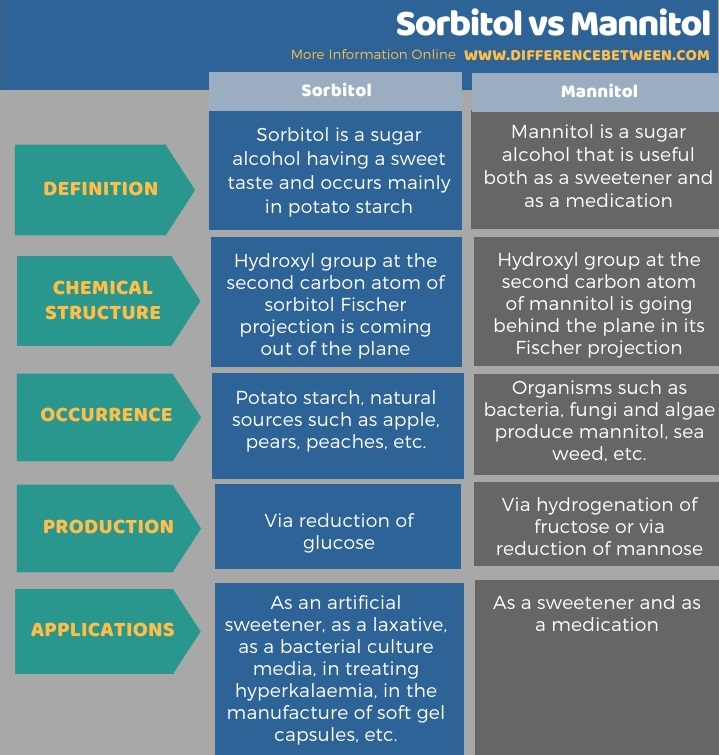Difference Between Sorbitol and Mannitol
Table of Contents
The key difference between sorbitol and mannitol is that the hydroxyl group at the second carbon atom of sorbitol Fischer projection is coming out of the plane, whereas in mannitol, the hydroxyl group at the second carbon atom of mannitol is going behind the plane in its Fischer projection.
Sorbitol and mannitol are structural isomers. Both these are sweet-tasting sugar molecules and are useful as artificial sweeteners.
CONTENTS
1. Overview and Key Difference
2. What is Sorbitol
3. What is Mannitol
4. Side by Side Comparison – Sorbitol vs Mannitol in Tabular Form
5. Summary
What is Sorbitol?
Sorbitol is a sugar alcohol having a sweet taste and occurs mainly in potato starch. It is slowly metabolized by the human body. We can obtain sorbitol via glucose reduction. Here, the aldehyde group of glucose is changed into a primary alcohol group. Therefore, sorbitol is an alcohol. We can find sorbitol as a naturally occurring compound; e.g. in apple, pears, peaches, etc. However, we mostly obtain sorbitol from potato starch.
When synthesized, sorbitol appears as a crystalline white powder. The major pathway of production is the glucose reduction reaction in which the aldehyde group is converted into an alcohol group. This reaction requires NADH and occurs in the presence of a catalyst – aldose reductase. Glucose reduction is a pathway of polyol production in glucose metabolism.

Figure 01: Chemical Structure of Sorbitol
There are several applications of sorbitol: as an artificial sweetener, as a laxative, as a bacterial culture media, in treating hyperkalaemia, in the manufacture of soft gel capsules, etc. Sorbitol is also useful in the cosmetic industry as a humectant and as a thickener. Besides, there are miscellaneous uses of sorbitol such as the manufacture of rocket fuel, production of biomass resources, etc.
What is Mannitol?
Mannitol is a sugar alcohol that is useful both as a sweetener and as a medication. Since it is poorly absorbed by the intestine, we can use mannitol in diabetic food. As a medication, we can use mannitol to decrease pressure in eyes and lower increased intracranial pressure. It can be administrated in the form of an injection in medical purposes.

Figure 02: Chemical Structure of Mannitol
Mannitol is an isomer of sorbitol. These two sugar alcohols differ from each other according to the orientation of the hydroxyl group that is attached to the second carbon atom of the sugar molecule.
We can obtain mannitol via the reduction of mannose sugar. However, the industrial-scale synthesis of mannitol is via the hydrogenation of fructose. Moreover, some organisms produce mannitol as a source of energy, e.g. bacteria, fungi, algae, lichens, etc. In addition, we can directly extract mannitol from its natural sources such as seaweed.
What is the Difference Between Sorbitol and Mannitol?
Sorbitol and mannitol are structural isomers. The key difference between sorbitol and mannitol is that the hydroxyl group at the second carbon atom of sorbitol Fischer projection is coming out of the plane, whereas in mannitol, the hydroxyl group at the second carbon atom of mannitol is going behind the plane in its Fischer projection.
We can find sorbitol as a naturally occurring compound; e.g. in apple, pears, peaches, etc. We mostly obtain sorbitol from potato starch. Some organisms produce mannitol as a source of energy, e.g. bacteria, fungi, algae, lichens, etc.
Below infographic tabulates the differences between sorbitol and mannitol.

Summary – Sorbitol vs Mannitol
Sorbitol and mannitol are structural isomers. The key difference between sorbitol and mannitol is that the hydroxyl group at the second carbon atom of sorbitol Fischer projection is coming out of the plane, whereas in mannitol, the hydroxyl group at the second carbon atom of mannitol is going behind the plane in its Fischer projection.
Reference:
1. “D-Sorbitol.” National Center for Biotechnology Information. PubChem Compound Database, U.S. National Library of Medicine, Available here.
2. “Sorbitol.” Wikipedia, Wikimedia Foundation, 23 Feb. 2020, Available here.
3. “Mannitol.” DrugBank, Available here.
Image Courtesy:
1. “D-sorbitol” By Mrgreen71 – Own work (CC BY-SA 3.0) via Commons Wikimedia
2. “Mannitol structure” By Edgar181 – Own work (Public Domain) via Commons Wikimedia
ncG1vNJzZmivp6x7pbXFn5yrnZ6YsqOx07CcnqZemLyue8OinZ%2Bdopq7pLGMm5ytr5Wau26%2FzquZoqyfoXqiusNmpJqmnp7BsLiO